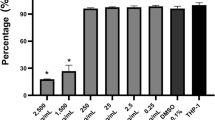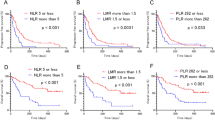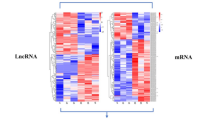Abstract
Aim:
In this study, we investigated the regulatory effects of honokiol on various inflammatory events mediated by monocytes/macrophages (U937/RAW264.7 cells) and lymphocytes (splenic lymphocytes and CTLL-2 cells) and their putative action mechanism.
Methods:
In order to investigate the regulatory effects, various cell lines and primary cells (U937, RAW264.7, CTLL-2 cells, and splenic lymphocytes) were employed and various inflammatory events, such as the production of inflammatory mediators, cell adhesion, cell proliferation, and the early signaling cascade, were chosen.
Results:
Honokiol strongly inhibited various inflammatory responses, such as: (i) the upregulation of nitric oxide (NO), prostaglandin E2 and TNF-α production and costimulatory molecule CD80 induced by lipopolysaccharide (LPS); (ii) the functional activation of β1-integrin (CD29) assessed by U937 cell-cell and cell-fibronectin adhesions; (iii) the enhancement of lymphocytes and CD8+CTLL-2 cell proliferation stimulated by LPS, phytohemaglutinin A (PHA), and concanavalin A or interleukin (IL)-2; and (iv) the transcriptional upregulation of inducible NO synthase, TNF-α, cyclooxygenase-2, IL-12, and monocyte chemoattractant protein (MCP)-1. These anti-inflammatory effects of honokiol seem to be mediated by interrupting the early activated intracellular signaling molecule phosphoinositide 3-kinase (PI3K)/Akt, but not Src, the extracellular signal-regulated kinase, and p38, according to pharmacological, biochemical, and functional analyses.
Conclusion:
These results suggest that honokiol may act as a potent anti-inflammatory agent with multipotential activities due to an inhibitory effect on the PI3K/Akt pathway.
Similar content being viewed by others
Log in or create a free account to read this content
Gain free access to this article, as well as selected content from this journal and more on nature.com
or
References
Stafford JL, Neumann NF, Belosevic M . Macrophage-mediated innate host defense against protozoan parasites. Crit Rev Microbiol 2002; 28: 187–248.
Newman SL . Macrophages in host defense against Histoplasma capsulatum. Trends Microbiol 1999; 7: 67–71.
Shiloh MU, Nathan CF . Reactive nitrogen intermediates and the pathogenesis of Salmonella and mycobacteria. Curr Opin Microbiol 2000; 3: 35–42.
Cherayil BJ, Antos D . Inducible nitric oxide synthase and salmonella infection. Microbes Infect 2001; 3: 771–6.
Fujiwara N, Kobayashi K . Macrophages in inflammation. Curr Drug Targets Inflamm Allergy 2005; 4: 281–6.
Appel S, Mirakaj V, Bringmann A, Weck MM, Grunebach F, Brossart P . PPAR-gamma agonists inhibit toll-like receptor-mediated activation of dendritic cells via the MAP kinase and NF-kappaB pathways. Blood 2005; 106: 3888–94.
Ojaniemi M, Glumoff V, Harju K, Liljeroos M, Vuori K, Hallman M . Phosphatidylinositol 3-kinase is involved in Toll-like receptor 4-mediated cytokine expression in mouse macrophages. Eur J Immunol 2003; 33: 597–605.
Wang X, Wang Y, Geng Y, Li F, Zheng C . Isolation and purification of honokiol and magnolol from cortex Magnoliae officinalis by high-speed counter-current chromatography. J Chromatogr A 2004; 1036: 171–5.
Ou HC, Chou FP, Sheu WH, Hsu SL, Lee WJ . Protective effects of magnolol against oxidized LDL-induced apoptosis in endothelial cells. Arch Toxicol 2007; 81: 421–32.
Liou KT, Shen YC, Chen CF, Tsao CM, Tsai SK . Honokiol protects rat brain from focal cerebral ischemia-reperfusion injury by inhibiting neutrophil infiltration and reactive oxygen species production. Brain Res 2003; 992: 159–66.
Bang KH, Kim YK, Min BS, Na MK, Rhee YH, Lee JP, et al. Antifungal activity of magnolol and honokiol. Arch Pharm Res 2000; 23: 46–9.
Kong ZL, Tzeng SC, Liu YC . Cytotoxic neolignans: an SAR study. Bioorg Med Chem Lett 2005; 15: 163–6.
Lin YR, Chen HH, Ko CH, Chan MH . Neuroprotective activity of honokiol and magnolol in cerebellar granule cell damage. Eur J Pharmacol 2006; 537: 64–9.
Lee B, Kim CH, Moon SK . Honokiol causes the p21WAF1-mediated G(1)-phase arrest of the cell cycle through inducing p38 mitogen activated protein kinase in vascular smooth muscle cells. FEBS Lett 2006; 580: 5177–84.
Ishitsuka K, Hideshima T, Hamasaki M, Raje N, Kumar S, Hideshima H, et al. Honokiol overcomes conventional drug resistance in human multiple myeloma by induction of caspase-dependent and -independent apoptosis. Blood 2005; 106: 1794–800.
Tse AK, Wan CK, Zhu GY, Shen XL, Cheung HY, Yang M, et al. Magnolol suppresses NF-kappaB activation and NF-kappaB regulated gene expression through inhibition of IkappaB kinase activation. Mol Immunol 2007; 44: 2647–58.
Tse AK, Wan CK, Shen XL, Yang M, Fong WF . Honokiol inhibits TNF-alpha-stimulated NF-kappaB activation and NF-kappaB-regulated gene expression through suppression of IKK activation. Biochem Pharmacol 2005; 70: 1443–57.
Lee J, Jung E, Park J, Jung K, Lee S, Hong S, et al. Anti-inflammatory effects of magnolol and honokiol are mediated through inhibition of the downstream pathway of MEKK-1 in NF-kappaB activation signaling. Planta Med 2005; 71: 338–43.
Munroe ME, Arbiser JL, Bishop GA . Honokiol, a natural plant product, inhibits inflammatory signals and alleviates inflammatory arthritis. J Immunol 2007; 179: 753–63.
Cho JY, Chain BM, Vives J, Horejsi V, Katz DR . Regulation of CD43-induced U937 homotypic aggregation. Exp Cell Res 2003; 290: 155–67.
Cho JY, Baik KU, Jung JH, Park MH . In vitro anti-inflammatory effects of cynaropicrin, a sesquiterpene lactone, from Saussurea lappa. Eur J Pharmacol 2000; 398: 399–407.
Cho JY, Fox DA, Horejsi V, Sagawa K, Skubitz KM, Katz DR, et al. The functional interactions between CD98, beta1-integrins, and CD147 in the induction of U937 homotypic aggregation. Blood 2001; 98: 374–82.
Cho JY, Skubitz KM, Katz DR, Chain BM . CD98-dependent homotypic aggregation is associated with translocation of protein kinase Cdelta and activation of mitogen-activated protein kinases. Exp Cell Res 2003; 286: 1–11.
Larrucea S, Gonzalez-Rubio C, Cambronero R, Ballou B, Bonay P, Lopez-Granados E, et al. Cellular adhesion mediated by factor J, a complement inhibitor. Evidence for nucleolin involvement. J Biol Chem 1998; 273: 31718–25.
Bradford MM . A rapid and sensitive method for the quantitation of microgram quantities of protein utilizing the principle of protein-dye binding. Anal Biochem 1976; 72: 248–54.
Raso GM, Pacilio M, Di Carlo G, Esposito E, Pinto L, Meli R . In-vivo and in-vitro anti-inflammatory effect of Echinacea purpurea and Hypericum perforatum. J Pharm Pharmacol 2002; 54: 1379–83.
Cieslik K, Zhu Y, Wu KK . Salicylate suppresses macrophage nitric-oxide synthase-2 and cyclo-oxygenase-2 expression by inhibiting CCAAT/enhancer-binding protein-beta binding via a common signaling pathway. J Biol Chem 2002; 277: 49304–10.
Berg J, Fellier H, Christoph T, Grarup J, Stimmeder D . The analgesic NSAID lornoxicam inhibits cyclooxygenase (COX)-1/-2, inducible nitric oxide synthase (iNOS), and the formation of interleukin (IL)-6 in vitro. Inflamm Res 1999; 48: 369–79.
Son HJ, Lee HJ, Yun-Choi HS, Ryu JH . Inhibitors of nitric oxide synthesis and TNF-alpha expression from Magnolia obovata in activated macrophages. Planta Med 2000; 66: 469–71.
Matsuda H, Kageura T, Oda M, Morikawa T, Sakamoto Y, Yoshikawa M . Effects of constituents from the bark of Magnolia obovata on nitric oxide production in lipopolysaccharide-activated macrophages. Chem Pharm Bull (Tokyo) 2001; 49: 716–20.
Cho JY, Park J, Kim PS, Yoo ES, Baik KU, Park MH . Savinin, a lignan from Pterocarpus santalinus inhibits tumor necrosis factor-alpha production and T cell proliferation. Biol Pharm Bull 2001; 24: 167–71.
Cho JY, Baik KU, Yoo ES, Yoshikawa K, Park MH . In vitro antiinflammatory effects of neolignan woorenosides from the rhizomes of Coptis japonica. J Nat Prod 2000; 63: 1205–9.
Cho JY, Yoo ES, Baik KU, Park MH, Han BH . In vitro inhibitory effect of protopanaxadiol ginsenosides on tumor necrosis factor (TNF)-alpha production and its modulation by known TNF-alpha antagonists. Planta Med 2001; 67: 213–8.
Park J, Lee J, Jung E, Park Y, Kim K, Park B, et al. In vitro antibacterial and anti-inflammatory effects of honokiol and magnolol against Propionibacterium sp. Eur J Pharmacol 2004; 496: 189–95.
Liou KT, Shen YC, Chen CF, Tsao CM, Tsai SK . The anti-inflammatory effect of honokiol on neutrophils: mechanisms in the inhibition of reactive oxygen species production. Eur J Pharmacol 2003; 475: 19–27.
Maulik N, Das DK . Redox signaling in vascular angiogenesis. Free Radic Biol Med 2002; 33: 1047–60.
Bharti AC, Aggarwal BB . Nuclear factor-kappa B and cancer: its role in prevention and therapy. Biochem Pharmacol 2002; 64: 883–8.
Bochkov VN, Leitinger N . Anti-inflammatory properties of lipid oxidation products. J Mol Med 2003; 81: 613–26.
Aggarwal BB, Sethi G, Ahn KS, Sandur SK, Pandey MK, Kunnumakkara AB, et al. Targeting signal-transducer-and-activator-of-transcription-3 for prevention and therapy of cancer: modern target but ancient solution. Ann N Y Acad Sci 2006; 1091: 151–69.
Park EJ, Kim SY, Zhao YZ, Sohn DH . Honokiol reduces oxidative stress, c-jun-NH2-terminal kinase phosphorylation and protects against glycochenodeoxycholic acid-induced apoptosis in primary cultured rat hepatocytes. Planta Med 2006; 72: 661–4.
Ahn KS, Sethi G, Shishodia S, Sung B, Arbiser JL, Aggarwal BB . Honokiol potentiates apoptosis, suppresses osteoclastogenesis, and inhibits invasion through modulation of nuclear factor-kappaB activation pathway. Mol Cancer Res 2006; 4: 621–33.
Li L, Sampat K, Hu N, Zakari J, Yuspa SH . Protein kinase C negatively regulates Akt activity and modifies UVC-induced apoptosis in mouse keratinocytes. J Biol Chem 2006; 281: 3237–43.
Lou L, Urbani J, Ribeiro-Neto F, Altschuler DL . cAMP inhibition of Akt is mediated by activated and phosphorylated Rap1b. J Biol Chem 2002; 277: 32799–806.
Yamamoto Y, Gaynor RB . Role of the NF-kappaB pathway in the pathogenesis of human disease states. Curr Mol Med 2001; 1: 287–96.
Yamamoto Y, Gaynor RB . IkappaB kinases: key regulators of the NF-kappaB pathway. Trends Biochem Sci 2004; 29: 72–9.
Moissoglu K, Sachdev S, Gelman IH . Enhanced v-Src-induced oncogenic transformation in the absence of focal adhesion kinase is mediated by phosphatidylinositol 3-kinase. Biochem Biophys Res Commun 2005; 330: 673–84.
Caron RW, Yacoub A, Li M, Zhu X, Mitchell C, Hong Y, et al. Activated forms of H-RAS and K-RAS differentially regulate membrane association of PI3K, PDK-1, and AKT and the effect of therapeutic kinase inhibitors on cell survival. Mol Cancer Ther 2005; 4: 257–70.
Chen SZ, Jia H, Wu YH, Wang H . Pharmacokinetics of honokiol in rats. Beijing Da Xue Xue Bao 2004; 36: 41–4. Chinese.
Bai X, Cerimele F, Ushio-Fukai M, Waqas M, Campbell PM, Govindarajan B, et al. Honokiol, a small molecular weight natural product, inhibits angiogenesis in vitro and tumor growth in vivo. J Biol Chem 2003; 278: 35501–7.
Author information
Authors and Affiliations
Corresponding author
Additional information
This work was supported by a Korea Research Foundation Grant (KRF-2006-C00455 to Jae Youl Cho).
Rights and permissions
About this article
Cite this article
Kim, B., Cho, J. Anti-inflammatory effect of honokiol is mediated by PI3K/Akt pathway suppression. Acta Pharmacol Sin 29, 113–122 (2008). https://doi.org/10.1111/j.1745-7254.2008.00725.x
Received:
Accepted:
Issue date:
DOI: https://doi.org/10.1111/j.1745-7254.2008.00725.x
Keywords
This article is cited by
-
Honokiol Attenuates Sepsis-Associated Acute Kidney Injury via the Inhibition of Oxidative Stress and Inflammation
Inflammation (2019)
-
Neuraminidase 1 regulates proliferation, apoptosis and the expression of Cadherins in mammary carcinoma cells
Molecular and Cellular Biochemistry (2019)
-
E2F2 directly regulates the STAT1 and PI3K/AKT/NF-κB pathways to exacerbate the inflammatory phenotype in rheumatoid arthritis synovial fibroblasts and mouse embryonic fibroblasts
Arthritis Research & Therapy (2018)
-
Honokiol and Magnolol Inhibit CXCL10 and CXCL11 Production in IL-27-Stimulated Human Oral Epithelial Cells
Inflammation (2018)
-
Deep sequencing of Magnoliae officinalis reveals upstream genes related to the lignan biosynthetic pathway
Journal of Forestry Research (2017)



